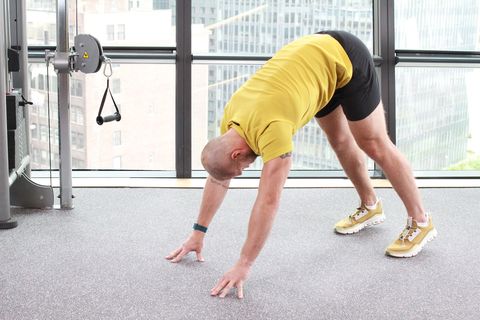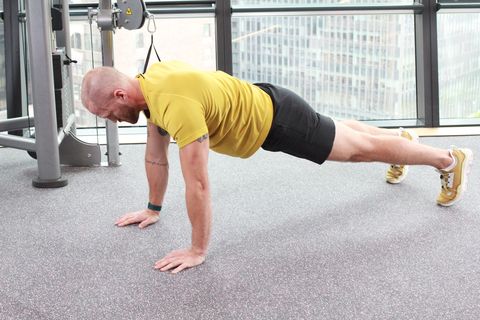If you ever did a sport—even if it was just youth league soccer or a casual track club—you’ve probably gone through a ringer of warmup exercises that included a move called the inchworm. The maneuver is accessible for all types of people (rambunctious kids included), and it’s even more effective than you might have ever guessed as you moved through the motions ahead of your practice or competition. The key to making the most out of the exercise is focusing on every single detail.
For Men’s Health fitness director Ebenezer Samuel, C.S.C.S., the inchworm is a great opportunity to work your abs in a way that goes beyond than your typical crunch to static plank combo. “Every so often, you need a different kind of core move,” he says. “Not a move that’s going to take you to fatigue or leave your abs feeling fried, but a move that’s going to help your abs feel great, that’s going to help you challenge a little bit of stability, that’s going to help you warm your core up, and is going to challenge your multi-planar stability maybe a little more than you may think.” Along with the benefits for your core, you’ll also get moving more than in some other, static stretches and stretch out your hamstrings more than you might expect.
That’s quite a few benefits from such a seemingly elementary-level exercise—not to mention that it’s a move you can do just about anywhere, without needing equipment. Just find enough space to take a plank position, and you’re good to go.

Before you recreate the inchworm of your youth, though, take a moment to learn the subtle keys to the exercise from Samuel and Men’s Health fitness editor Brett Williams. You’ll get more from your workout that way.
How to Do the Inchworm
Keep Your Legs Straight—Until You Can’t
In order to get the nice hamstring stretch we’re looking for with the early part of the exercise, you’re going to need to keep your legs straight. Start with your feet placed just beyond shoulder-width apart, then hinge at the hips to bend down and put your hands on the ground. As you descend, you want to keep your legs as straight as possible—but for some people, that will mean they will bend their knees. That’s just fine. Everyone has varying levels of flexibility.
But the goal is to go without the knee bend. “You eventually want to progress to the point that you’re keeping your legs as straight as possible, because the straighter you keep them, the more you’re going to get that really good hamstring stretch,” says Samuel.
Walk It Out Slow
The “inching” the move’s name refers to comes when you move from the bent-over position into the plank by moving forward on your hands. This is where the bulk of the benefits come from, too. But you don’t want to rush it, or you’ll throw yourself out of whack. Go slowly.
“This is the part where you get to explore your core a little bit and explore core stability,” says Samuel. That said, it’s important to make sure that as you place one hand in front of the other, you keep your elevated rear end steady. “Thinking hips and shoulders square to the ground the entire time,” he continues.


Own Your Pushup Plank
Once you walk your hands all the way to the end point, your focus shouldn’t flag. Now you have an opportunity to wring some more benefit out of the exercise. When you’re in that spot, you’re essentially holding a plank.
Like a normal plank, there are a few things you can do to make the static position a great core move. One, make sure to keep your spine straight, without rounding your back or depressing your pelvis. Two, make sure to keep your glutes, core, and shoulders engaged by squeezing those muscles.
Walk It Up Right
Getting back up to the starting position shouldn’t be as easy as just standing back up. You should instead keep the focus until you’re at the top.
“Let’s take the opportunity when we stand up to use this as a chance to drive your hips up to proper extension,” says Samuel. “We’re essentially coming back up from a Romanian deadlift.” Squeeze your glutes as you stand, keeping your hips and shoulders square, and walk your hands back.
Want to master even more moves? Check out our entire Form Check series.
Source: Read Full Article
